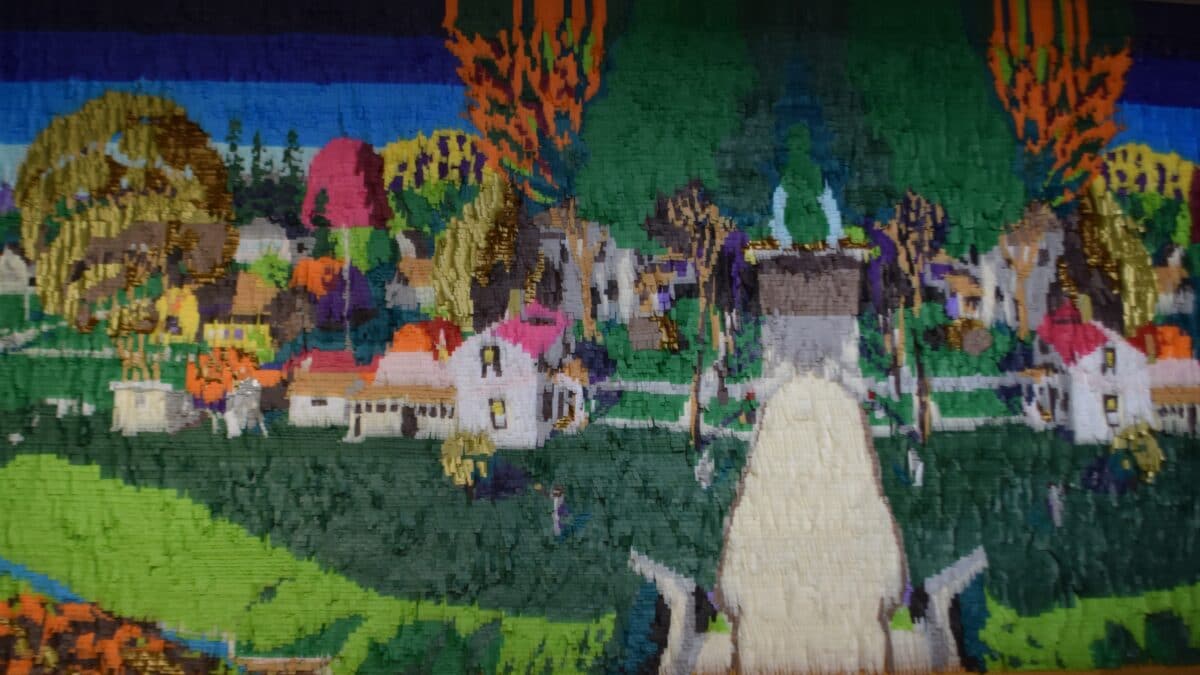
Favela’s solo exhibition is inspired by Latinx culture, art history and food rendered in layers of vibrant strips of paper — recalling piñatas and party decorations
For Immediate Release
Contact: Jordan Powers
Tel: 630.470.5136 (m)
E-mail: jpowers@desmoinesartcenter.org
DES MOINES, IA (May 2021) – On July 17, Justin Favela’s exuberant, large-scale installations will fill two gallery spaces at the Des Moines Art Center with the exhibition Justin Favela: Central American.
Favela’s art is inspired by Latinx culture, art history and food rendered in layer upon layer of vibrant strips of paper. His technique recalls piñatas and party decorations — ephemeral forms that signify joy and celebration.
“I like making fun and colorful work that is accessible as a way to push the boundaries of the materials I use and to also bate the audience with beauty. I think that comes from my experience growing up in Las Vegas where it is all about the facade. There is always a deeper meaning behind my work if you are willing to look past the fluff,” Favela said.
The exhibition’s subtitle, Central American, contains multiple meanings, suggesting the artist’s heritage, Iowa’s place in the middle of America and the strong presence of Central Americans in the state and within the agricultural industry upon which the economy depends.
All of the work in the exhibition will be created on site by Favela, including a large-scale installation, wall and floor sculptures and a paper chandelier for the Richard Meier building’s atrium.
“I started using tissue paper when I made my first “piñata” sculpture over 10 years ago,” Favela said. “I wanted to make a sculpture that would stand as a symbol for the commodification of Latinx culture. After years of making piñatas, I started to think of them as a medium that expanded the scope of my work from sculpture to installation and “painting”.”
Justin Favela: Central American is organized by Des Moines Art Center Curatorial Manager Laura Burkhalter. The exhibition will run through October 24, 2021.
“Justin’s work is so joyful and such a visual delight. I think this exhibition will be a favorite with the community, and I can’t wait for them to see what Justin makes for us,” Burkhalter said. “I know “summer fun” and museums are not always words used together, but this show may change that perception.”
Visit desmoinesartcenter.org in the coming weeks to explore exhibition-related programming, including a virtual artist lecture and “nacho nosh” on August 19 and special, exhibition-related episodes of Favela’s Art People podcast.
Justin Favela: Central American is supported by National Endowment for the Arts, Humanities Iowa and the National Endowment for the Humanities, The Andy Warhol Foundation for the Visual Arts, Faegre Drinker Biddle & Reath LLP and ASK Studio.
For further information, interviews/quotes or exhibition images, please contact Director of External Affairs Jordan Powers at 630.470.5136 or jpowers@desmoinesartcenter.org.
FEATURE IMAGE CAPTION:
Justin Favela
Central American, 2021 (detail)
Paper and glue
Courtesy of the artist
About the Des Moines Art Center + John and Mary Pappajohn Sculpture Park
Recognized by international art critics as a world-class museum in the heart of the Midwest, the
Des Moines Art Center, an AAM-accredited institution, has amassed an important collection of art from the 19th century to the present, with a major emphasis on contemporary art. Focused on quality and global in scope, it includes major works by Henry Ossawa Tanner, Edward Hopper, Georgia O’Keeffe, Francis Bacon, Andy Goldsworthy, Henri Matisse, Wangechi Mutu, Ai Wei Wei and Kara Walker, among hundreds of others. The collection is housed in three major buildings, each designed by a renowned architect—Eliel Saarinen, I. M. Pei and Richard Meier. With the exception of special events, admission to the museum is free.
In September 2009, the John and Mary Pappajohn Sculpture Park opened in Des Moines’ Western Gateway Park. Philanthropists John and Mary Pappajohn provided funding for and donated 31 sculptures by internationally acclaimed contemporary artists to the Des Moines Art Center. The collection of sculptures by such artists as Martin Puryear, Louise Bourgeois, Deborah Butterfield, Willem de Kooning, Mark di Suvero, Olafur Eliasson, Keith Haring, Robert Indiana, Ellsworth Kelly, Yayoi Kusama, Jaume Plensa, Richard Serra and Joel Shapiro is the most significant donation of artwork to the Art Center in a single gift in the museum’s history. The Pappajohn Sculpture Park is a collaboration of the Pappajohns, the City of Des Moines, the Des Moines Art Center and numerous corporate and private donors.
# # #